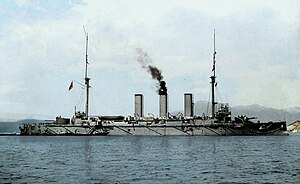 Yakumo at anchor in Kure, 8 April 1905
| |
| Class overview | |
|---|---|
| Operators | |
| Preceded by | Izumo class |
| Succeeded by | Azuma |
| History | |
| Name | Yakumo |
| Namesake | A stanza of waka |
| Ordered | 1 September 1897 |
| Builder | AG Vulcan Stettin, Stettin, Germany |
| Laid down | 1 September 1897 |
| Launched | 8 July 1899 |
| Completed | 20 June 1900 |
| Reclassified |
|
| Stricken | 1 October 1945 |
| Fate | Scrapped, 20 July 1946 |
| General characteristics | |
| Type | Armored cruiser |
| Displacement | 9,646 t (9,494 long tons) |
| Length | 132.3 m (434 ft 1 in) (o/a) |
| Beam | 19.57 m (64 ft 2 in) |
| Draft | 7.21 m (23 ft 8 in) |
| Installed power |
|
| Propulsion |
|
| Speed | 20 knots (37 km/h; 23 mph) |
| Range | 7,000 nmi (13,000 km; 8,100 mi) at 10 knots (19 km/h; 12 mph) |
| Complement | 670 |
| Armament |
|
| Armor |
|
Yakumo (八雲, Eight Clouds) was an armored cruiser (Sōkō jun'yōkan) built for the Imperial Japanese Navy (IJN) in the late 1890s. As Japan lacked the industrial capacity to build such warships itself, the ship was built in Germany. She participated in most of the naval battles of the Russo-Japanese War of 1904–05, and was lightly damaged during the Battle of the Yellow Sea and the Battle of Tsushima. Yakumo saw no combat during World War I and began the first of many training cruises in 1917, although she was not officially reclassified as a training ship until 1931. Her last training cruise was in 1939, but the ship continued to conduct training in home waters throughout the Pacific War. Yakumo became a repatriation transport after the war and was broken up in 1946–47.